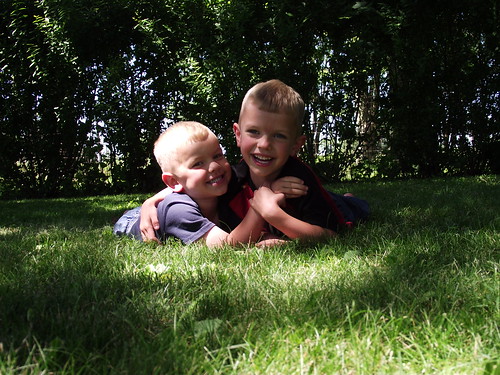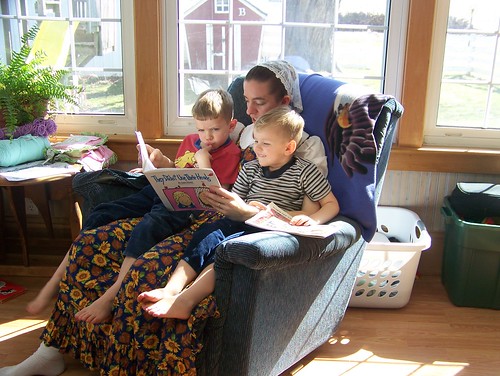
First, I want to thank you all for praying for my dear friend’s 5 year old daughter who had spinal meningitis–PRAISE the LORD it was viral! She is home and doing well–better and better each day!
![]()
I know you’ve all heard of the “3Rs”–Readin’, wRitin’ and aRithmatic. (Not good for spelling, but I guess it works! LOL!)
I have another “acronym” use for the 3Rs–Relationship, Relationship, Relationship! ![]()
(That’s Relationship with God, Relationship with your husband, and Relationship with your children!)
So today, I’m going to address the first R on the academic side–or should we call it, First R (a)?!
First the “Readin” R.
Teaching your child to read can be one of the most rewarding things in life!
Teaching your child to read can be one of the most frustrating things in life!
It all depends on your motivation and your approach! Are you teaching them out of fear of state standards? What your mother (or neighbor) thinks? Because all your homeschooling friends are? Because they’re “supposed to” know how to read by age 6? (I’m sure it’s stated somewhere in Scripture….maybe one of our pastor friend’s favorite book of 2 Hezekiah! ![]() )
)
Why do we teach our children to read? I mean, really?
-
So they can function in society
-
So they can eventually learn independently, requiring less of mama’s oversight
-
So they can read and learn God’s Word
All of those are really good reasons, but of course you know the third one is the most important. If you teach your child to read at 6 (or 3 or 10 or whatever) and they function well and successfully in society, but they don’t pick up the Scriptures and read them and allow God to speak to them through Them…..then what good was teaching them to read?
We “reward” the children when they learn to read by buying them a nice Bible with their name imprinted on it. I buy a large print Bible, making it easier for beginner reading eyes to read. So far, only one of the 4 older girls has bought a different Bible than the one she started with–and that was after 7 years!
Each little girl excitedly asks, “When will I get my Bible?!” We usually give it to them for their birthday or Christmas, whichever comes next after they learn to read. No, they probably can’t understand every word, but they are quite proud to have a Bible of their own to do copywork out of and to read for “quiet time”!
I will confess that so far, 5 of my 7 girls have been later bloomers in reading. I was worried about the first late bloomer, and one day I thought, “Isn’t this why I homeschool? To be able to allow them to learn at their pace?”
I relaxed a little and backed off being so intense. By 8 1/2 she was reading, and by 11 I had to pry her nose out of books! I remember one season I actually had to limit her reading!!!
Now, what was I worried about? ![]()
I realize there are sometimes issues that make it hard to learn to read and I am not qualified to advise about that.
So what did I use?
I started with Writing Road to Reading. Very thorough. Very intense. After 6 weeks, Jessica and I were both tired of it! I then used a “method” I had heard at a homeschooling conference. I use the word “method” loosely! There was no curriculum, no books. If you have something that has the basic phonics rules in it, that will do.
The lady sharing this used Matthew 5 to teach her child reading. No kidding! I started doing that with Jessica, and she delightedly said, “Mommy, I like this so much better than when you stand at the chalkboard and say, ‘old’!”
You take the first part of Matthew 5:1: “And seeing the multitudes….”
And. You would help your child sound this out (obviously, you have taught the sounds by now. Maybe just to these letters plus a few). Now have your child add a “b”. Baaaannnnnd. “h” Haaaannnnnnd. Even have them try the ones that don’t make words. “j” Jannnnnnd.
You get the idea!
You’d teach that in a short word, the vowel usually makes it’s “short” sound.
You might only do that for one day or several, depending on your child. Then the next time, drop the “d” at the end and do it all over again!
ban, can, Dan (could quick point out we make “mama letters” for names!), fan, man, pan, ran, tan, van.
Next time, take off the n and put the d back on. You’re off!
bad, dad (or Dad!), fad, had, lad, mad, pad, sad
Next go to “see”–the first syllable in “seeing”. You could even spend a “lesson” or two on syllables, having your child clap the names in your family. Don’t quiz them on it or make a big deal about it. Have fun!
Okay, so “see” makes the “long e” sound. Here we go again!
bee, Dee (if you know anyone with that name!), fee, Lee, wee (vocab–tell them it means small!)
Obviously some harder ones you won’t do. And if they say, “Oh, nee!” you can explain that’s a special one that they’ll learn later. Commend them for a good try!
Next is “ing”. You got it!
king, ping, ring, sing, wing
“The” would teach the “th” sound and that vowels at the end of a word say their name (or you could save that for “he” later in the verse!).
“Multitudes” has the CVC as well as the CVCV patterns. If that is Greek to you, I mean:
Consonant-short Vowel-Consonant (mul) such as “can” or “red” and
Consonant-Vowel-Consonant-Vowel (tude) such as “cane” or “rope”.
You can have fun teaching “silent e” and change words just by adding “e”! (Or the “when two vowels go walking the first one does the talking” rule).
can/cane; man/mane; pet/Pete; rob/robe…..
If that is hard to think through or follow, then the next easiest thing for me, and one I also used, was Ruth Beechik’s simple but wonderful (as anything by her is!) “The 3R Series“. The “readin'” one is “A Home Start in Reading” (although I’d buy all three!). And here is a review by Cathy Duffy. (Although I would disagree that they need extra “learning activities” to learn–mine didn’t always need that!)
Here is Cathy’s review of The 3R Series.
Even if you choose to use something more traditional, please read Mrs. Beechik’s A Home Start in Reading to demystify the whole process of reading for you!
Now maybe you need something YET a little more….structured. (That word is used sparingly around here…..LOL!) When Anna was learning to read my dad was falling and ending up at the hospital all the time, had surgery, ended up in a nursing home….so I needed something very simple. I went with a book that has mixed reviews, but we ended up liking it! Teach a Child to Read in 100 Easy Lessons. Here again is Mrs. Duffy’s review.
As she states, many people are hesitant because of the distorted alphabet. But I will tell you that it did not phase Anna. She took off reading, maybe had a few times I had to remind her of blends (like “sh” and “ch”), but overall did not have any issues with it. Another criticism of 100 Easy Lessons is that the stories are silly. Well, I didn’t find any of them bad, and yes, sometimes they were really off the wall, but the kids liked them! It is scripted and easy to pretty much look over in a day and use the next. I did NOT repeat everything as often as the book said, unless a child was having a huge problem with something. Plenty of review built in!
Now Bekah and Charissa didn’t care for it as much, so I invested in something I had been wanting to check out for awhile. Happy Phonics from Love to Learn.
I confess we do not do the Explode the Code workbooks with it. I had a post, “Happy Phonics, Happy Mama!” awhile back about how we do Happy Phonics. We ? Happy Phonics!
I would go with the regular set and pay shipping–there is an e-book option, but you get ALL of it already on cardstock for basically the same price! For busy mamas, it’s worth the extra few $$!
I have taught Rebekah mainly this way, and Charissa is learning. I’m reinforcing phonics with Anna to help with spelling–she loves it, too! Noah and Isaiah want to do it with me, too–but I keep it very low-key for them, as I explain in my other post.
Happy Phonics is where we’ll stay, I believe! And no, I don’t foresee doing the bookwork of Explode the Code–although of all the workbooks out there, I would recommend that series. Here is Cathy’s review of Explode the Code–one of her Top 100 Picks!
One last resource I would like to recommend, although it is not something you “take out of a box and do”, is Teach a Child to Read with Children’s Books by Mark B. Thogmartin.
I had one daughter that did not learn the traditional “phonics first” way. That’s why I love Mr. Thogmartin’s book! He says it’s not phonics or whole-word but both. Children really do use both ways to learn, and some lean more heavily on one than the other. The same daughter learns piano the same way–none of this right hand, then the left hand, then put them together. It’s put them together from the start! But that’s the way she learns.
I am editing this to say that the free copy on the internet is not by permission of Mr. Thogmartin and Mrs. Gallagher. He graciously commented below that he has rewritten his book and it is now available at Teach a Child to Read. My apologies to Mr. Thogmartin, as I didn’t know he was rewriting his excellent book and that the “free” ones were without his permission!
Although I have an older copy of his book, I may just spring for this revised version!
Do you know what I like about most of these “methods”? They don’t require a lot of drill and kill. And they can be done snuggling together on the couch! (Well, Happy Phonics is more on the floor! ![]() )
)
And you know me–anything that builds relationships is TOP on my priority list!
I hope something here is helpful to you, and let me tell you that there really is no great mystery or perfect curriculum. Sometimes you just need to allow time. But when they”take off”, it is the most thrilling thing to me!!!
Happy teaching, happy reading and happy snuggling! ![]()
